Enjoying four very distinct seasons during the year, Japan guarantees a season for all types of travellers. However, deciding on the best time to visit Japan will depend on what exactly you want to experience in the land of the rising sun.
While there is a huge disparity in temperature between Hokkaido in the north and Okinawa in the south, generally, Japan has plenty of great weather for much of the year. So whether it’s a spot of cherry blossom viewing, skiing in Hokkaido’s winter snow or being mesmerised by the radiant colours of autumn, Japan is a year-round destination (if you can stand the summer heat!).
For many, spring is the best time to visit Japan, thanks to the famous cherry blossoms that sprout throughout the country. Yet the cherry blossom season is both incredibly short and very popular, meaning there’s a lot of crowds.
Summer in Japan sees much of the country’s worst weather, which starts with the rainy season followed by stiflingly hot temperatures and high humidity.
Autumn brings much-needed respite, with chilly days, beautiful blue skies, and glorious autumn colours. In winter, temperatures fall further and snow covers much of the north of Japan, making it a beautiful winter wonderland, or an adventure playground for lovers of winter sports.
Best Time To Visit Japan
Top 3 Japan Tours
- Fuji-O Highland Amusement Park One-Day Pass – Enjoy thrilling rides at this theme park near Mt Fuji.
- Nagano Snow Monkeys – See the snow monkeys, visit Zenkoji Temple and drink sake on this exciting day trip.
- Tokyo SkyTree – Skip the line and book your Tokyo SkyTree tickets here.
Japan Rail Pass – Save $$$ and book your 7, 14 or 21-day JR Pass before you go. The pass allows you to travel on all JR trains across Japan, including the Narita Express and Shinkansen bullet train.
Japan in Summer
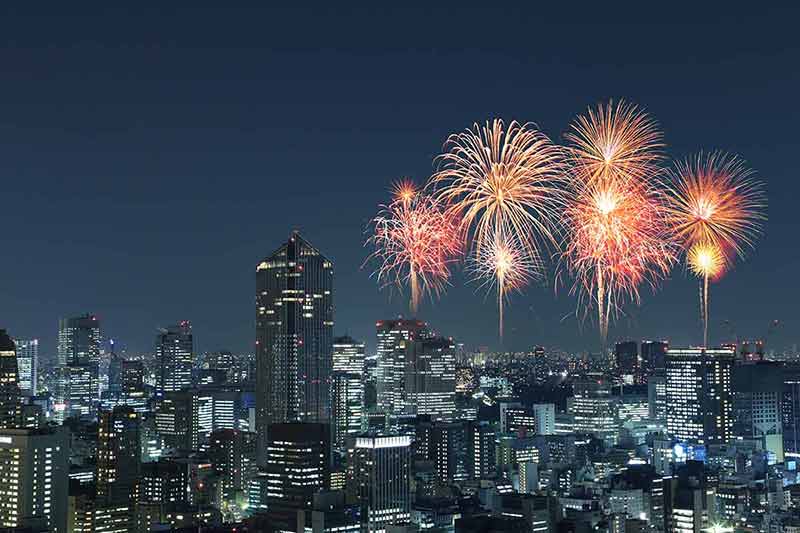
There is an excellent case to make for summer being the worst time of year to visit Japan.
Summer starts with an unforgiving rainy season that often includes fierce storms and even typhoons.
Days without rain are often grey and gloomy at the start of summer and once the rains have gone, the temperature in Japan rockets up, as does the humidity.
However, not all parts of Japan are affected in the same way during the summer.
Hokkaido and Okinawa don’t suffer as severely during the rainy season – the rain tends to hit Okinawa in May and often miss Hokkaido altogether.
But the humidity and high temperatures are certainly still a factor, especially in tropical Okinawa.
Yet because of the weather, the summer in Japan tends to be a quieter time to visit.
The cost of flights to Japan and accommodation can also be a little lower at this time of year.
However, summer in Japan also sees many traditional celebrations, including historical festivals and enormous fireworks displays.
These festivities – combined with the heat and the long school holidays that run from mid July to the end of August – help create a wonderful celebratory atmosphere across Japan in the second half of the summer.
Average Weather In Japan In Summer
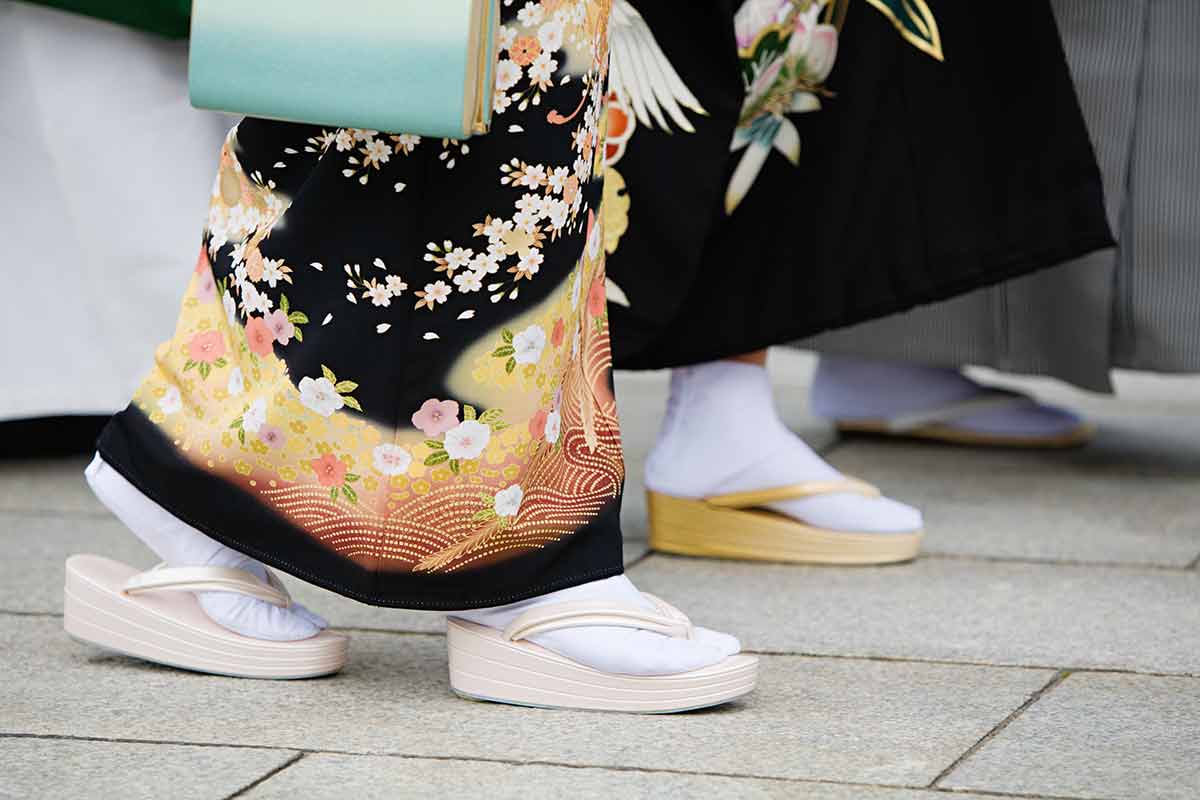
**All weather information provided is based on data for Tokyo
- June – Daylight hours – 14 hours, Average Low = 24 °C/75 °F, Average High = 28 °C/83 °F
- July – Daylight hours – 15 hours, Average Low = 25 °C/78 °F, Average High = 30 °C/86 °F
- August – Daylight hours – 14 hours, Average Low = 26 °C/79 °F, Average High = 30 °C/86 °F
Things To Do In Japan In Summer
1- Hit The beach
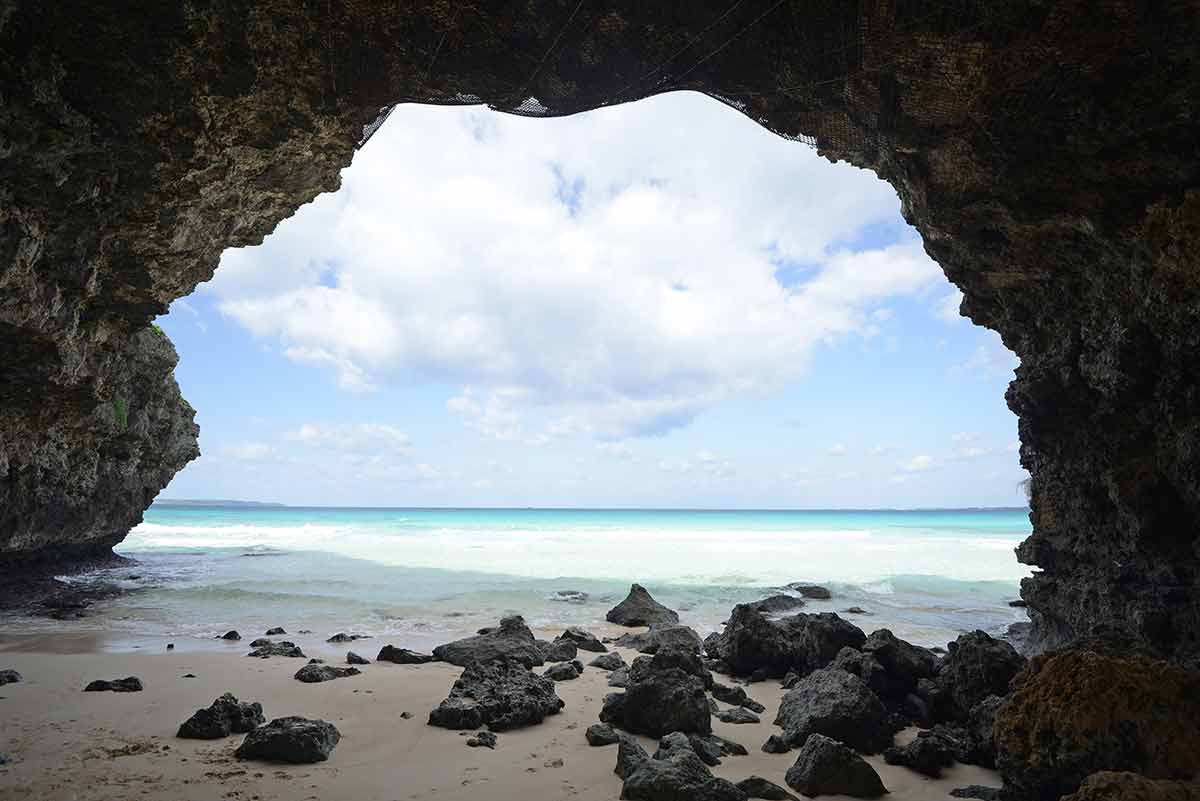
When the temperatures ramp up in summer in Japan, the beach is the best place for many.
Japan’s best beaches are the perfect place to enjoy a hot summer’s Day, and there are plenty to pick from too.
From Tokyo, the best beaches are just an hour’s train ride to the south, at either Zushi beach or Yuigahama beach, both of which are within easy reach of Kamakura.
2- Explore The Mountains
If hot and humid weather is not your cup of tea, do as many Japanese do and head to the mountains.
Many areas of Japan with a higher altitude benefit from cooler temperatures and much lower humidity during the hot summer.
The popular tourist spot of Nikko in Tochigi is one of these and makes for a great place to escape the heat.
Karuizawa in Nagano prefecture is another popular summertime retreat for those looking for cooler climes.
3- Watch The Summer Matsuri Celebrations
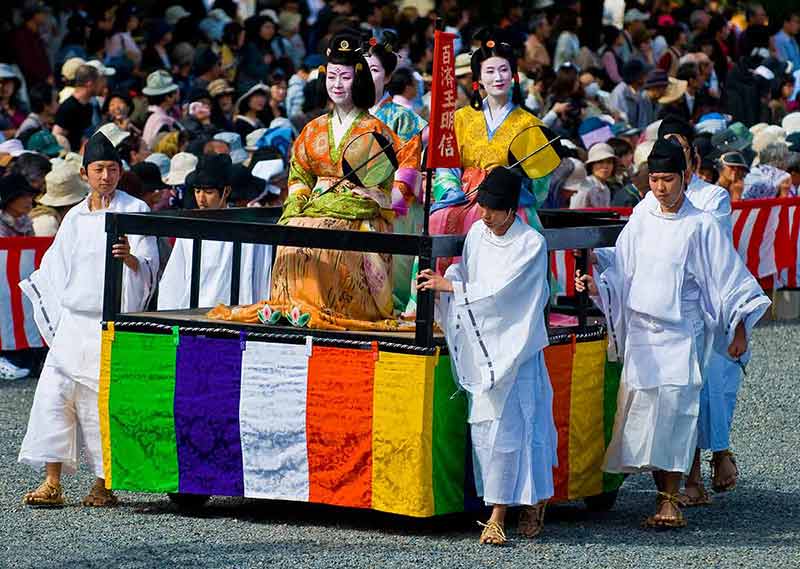
Summer festivals called matsuri take place all over Japan throughout the summer.
These age-old traditional celebrations are usually held over several days and have roots in Shintoism and Buddhism.
Many originated as ways of appeasing or appealing to various deities and Gods and the hope that they would provide a prosperous year ahead.
Matsuri typically involves around three days of celebrations.
Large groups of local people dressed in traditional dress carry portable shrines and floats around the streets near shrines and temples.
Street food and souvenir stalls are set up along the route or inside temple grounds, creating a carnival atmosphere.
The Sanja Festival in Asakusa in Tokyo is one of the most famous matsuri in the capital.
The Nebuta Festival in Aomori and the Gion Matsuri Festival in Kyoto are also the biggest in Japan.
4- Watch A Fireworks Display
Huge fireworks displays are another summertime tradition in Japan.
Many of Japan’s summer festivals will end with a fireworks display, though some displays are standalone events.
Called hanabi in Japanese, fireworks have long been used to deter evil spirits in Japan.
Today hundreds of fireworks displays are held throughout Japan every year, usually between July and August.
The largest fireworks display takes place on the Sumida River in eastern Tokyo, which runs for an hour and a half and draws massive crowds every year. Osaka’s Tenjin Matsuri and the Kamakura Fireworks Festival are two other massive fireworks displays not to be missed.
5- Climb Mount Fuji
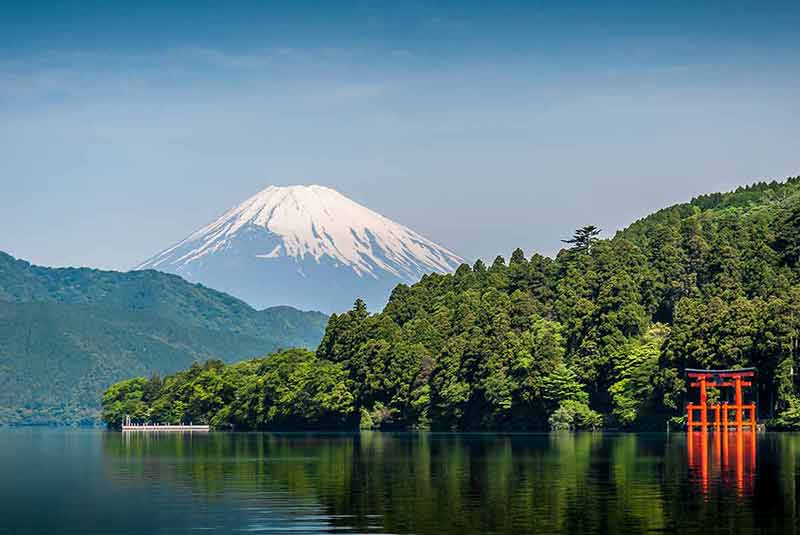
As Japan’s tallest mountain, the iconic Mount Fuji is the country’s most famous landmark.
Summer is the only time of year in which it is possible to climb Mount Fuji.
The various mountain trails that lead to the top of Fujisan are only open for three months a year, usually between early July and early September (actual dates vary from year to year).
The temperatures at the top of Mount Fuji are too cold at any other time of year for people to safely ascend, meaning that if you want to tick off a bucket-list ambition of climbing Japan’s most famous mountain, then you’ll need to do it in summer.
Japan Summer Tips
- If you’re travelling to Japan in early summer pack clothes for rainy as well as hot weather. It’s a terrible combination but unfortunately it is the reality for much of Japan in June and early July.
- There’s no escaping the humidity in Japan during the summer no matter where you are in the country. Fans are essential for keeping cool, whether they’re the traditional fold-out kind or modern battery-powered fans. If you feeling the heat, do like the Japanese do and pick up a fan to try and keep cool.
- Keep in mind that the school summer holidays take place from late July right the way through to the end of August. The uncomfortable summer weather does mean that the price of flights and accommodation in Japan is often lower towards the start of summer. However, the school holidays mean that many Japanese people take holidays in July and August when prices can often rise again. The availability of accommodation may also be an issue too, especially in more popular and touristy parts of Japan.
For more about Japan, read:
- 20 Incredible Landmarks in Japan
- 20 Best Beaches In Japan
- 25 Things To Do In Tokyo At Night
- 25 Landmarks In Tokyo
- A Guide To Winter In Japan
- 50 Things To Do In Japan
- Japan Itinerary (10 days)
- Where To Stay In Tokyo
- Osaka Itinerary
- Nagoya Itinerary
- Where To Stay In Nagoya
- 12 Things To Do in Takayama
- How To Use The Toilets In Japan
- Osaka Itinerary
- 20 Things To Do In Osaka At Night
- Where To Stay In Osaka
- 20 Things To Do In Hiroshima
- Where To Stay In Hiroshima
- 20 Things To Do In Yokohama
- 15 Things Japan Is Famous For
- 20 Things To Do In Kamakura
- 20 Things To Do In Nagano
- 20 Day Trips From Tokyo
- 3 Day Trips From Osaka
- The Most Beautiful Japan Tourist Spots
- Hakuba Hotels
- Hakuba Ski Resort
- Japanese Onsen Tips
- Where To Stay In Kyoto Like A Local
- Arashiyama Monkey Park
- Eating and Drinking Matcha
- Amanemu Review
- 20 Japanese Drinks
- 20 Things To Do In Kyoto At Night
- 20 Japanese Cities
- 20 Things To Do In Fukuoka
- Where To Stay In Fukuoka
- 20 Things To Do In Nara
- 20 Things To Do In Hakone
- 20 Things To Do In Sapporo
- Where To Stay In Sapporo
- 20 Things To Do In Kanazawa
- 20 Things To Do In Okinawa
- 20 Things To Do In Sendai
- 20 Things To Do In Saitama
Japan in Autumn
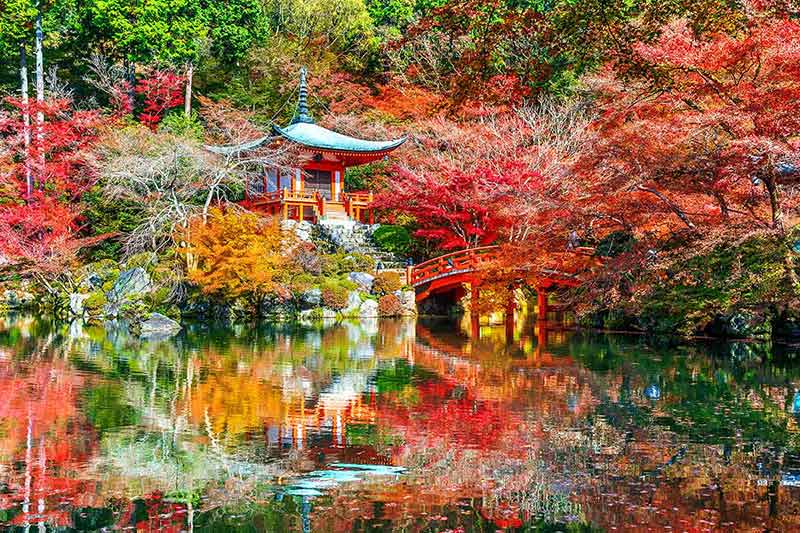
There are many reasons to suggest that autumn is the best time to visit Japan.
The drop to much more bearable temperatures after the unforgiving heat of the summer is one of them.
In early autumn, the humidity all but disappears, and temperatures tend to fall to around 22 °C/71 °F, cooling to near 14 °C/57 °F by November.
Days are often sunny, too, with beautiful blue skies for much of the season.
Perhaps the main reason autumn is a fantastic time to visit Japan is the stunning seasonal colours found throughout the country.
The vibrant autumn colours in Japan are a huge draw, with internal and international tourists travelling throughout Japan to get a glimpse of forests, parks and gardens filled with dazzling orange, red and yellow leaves.
Because of this, autumn is hectic, with trains and hotels often in high demand.
Average Weather In Japan In Autumn
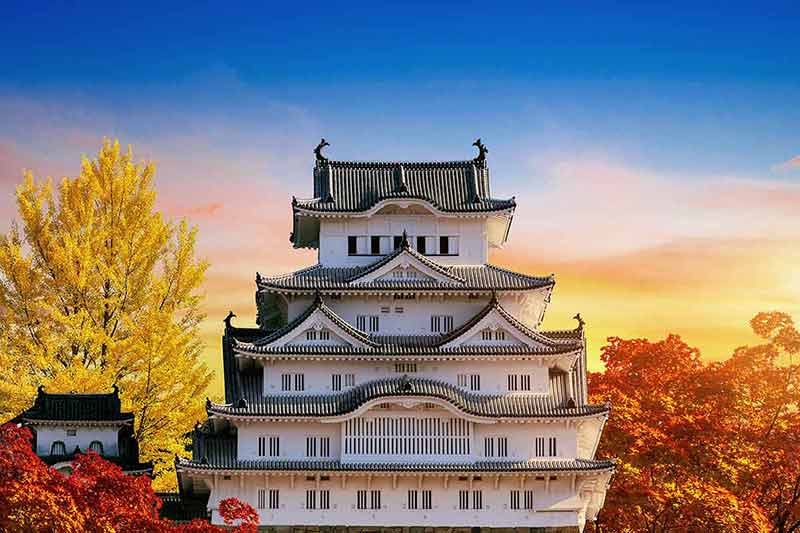
September – Daylight hours = 13 hours, Average Low = 25 °C/78 °F, Average High = 29 °C/85 °F
October – Daylight hours = 11 hours, Average Low =24 °C/75 °F, Average High= 28 °C/83 °F
November – Daylight hours = 10 hours, Average Low = 21 °C/70 °F, Average High = 25 °C/78 °F
Things to do in Japan in Autumn
1- Hike Through Colourful Mountains
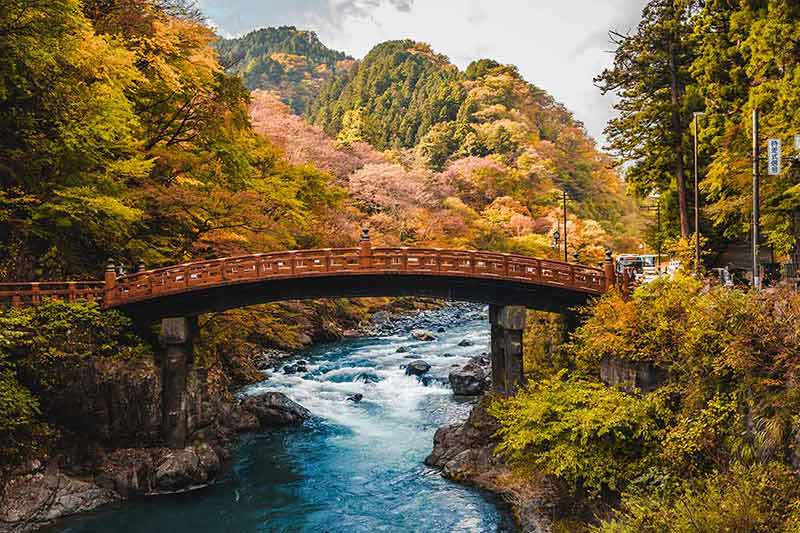
Autumn in Japan is a fantastic time to hike through forests or along the many mountain trails that meander through the countryside.
Japan’s autumn foliage is a sight to behold, and there are plenty of routes to explore for breathtaking views of the deep orange and red leaves that burst into colour at this time of year.
Many of these are near to major cities too.
A great range of hiking routes around Kamakura and Kyoto show off the breathtaking autumn colours.
Whether you prefer an easy stroll or something a little more challenging, there’s something for everyone.
Hiking through Japan’s beautiful rural scenes in the height of autumn is a truly unforgettable experience.
2- Visit A Traditional Japanese Garden
If heading on a hike sounds too much like hard work, visit a traditional Japanese garden instead.
There are plenty of Japanese gardens, and with the arrival of autumn, these also turn into a breathtaking array of colours.
Seasonal flowers are on display alongside the rich reds and yellows of the autumn trees.
There are many Japanese gardens in Tokyo to pick from, with Rikugien Gardens or Koishikawa Korakuen Gardens among the best.
In Kyoto, don’t miss the Japanese garden on the grounds of Yasaka Shrine.
3- Go Moon Viewing
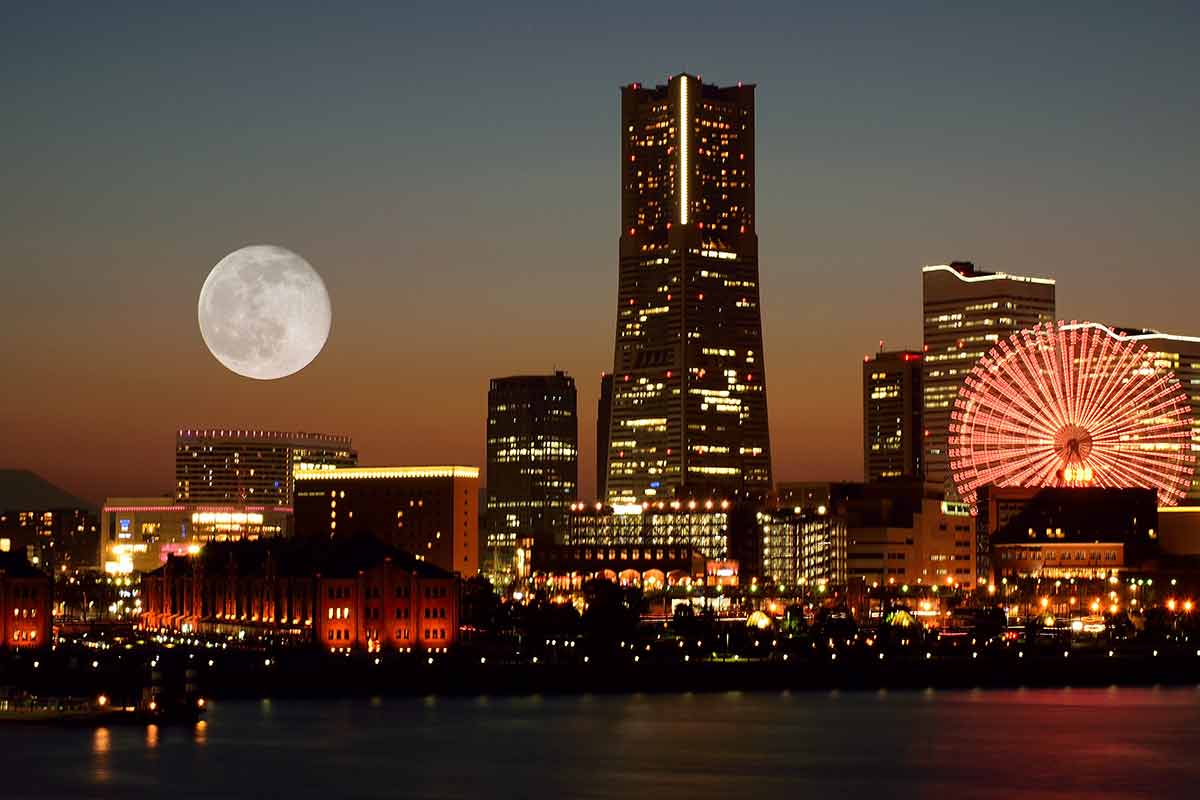
Another natural wonder of Japan’s autumns are the clear views of the moon.
Moon viewing is a famous pastime in Japan all year round but is mainly associated with autumn.
Known as tsukimi in Japanese, moon-viewing parties in Japan date back several centuries.
People gather to witness the large full moon that glows brightly in the sky, usually around early to mid-September and October.
Moon viewing parties are still prevalent in Japan today.
Each autumn, major events take place at some of Japan’s most famous landmarks, such as the Tokyo Tower and Himeji Castle, to mark the full moon.
Similar gatherings are held at shrines and temples, often with stalls set up selling traditional food and souvenirs.
4- Celebrate Halloween Japanese Style
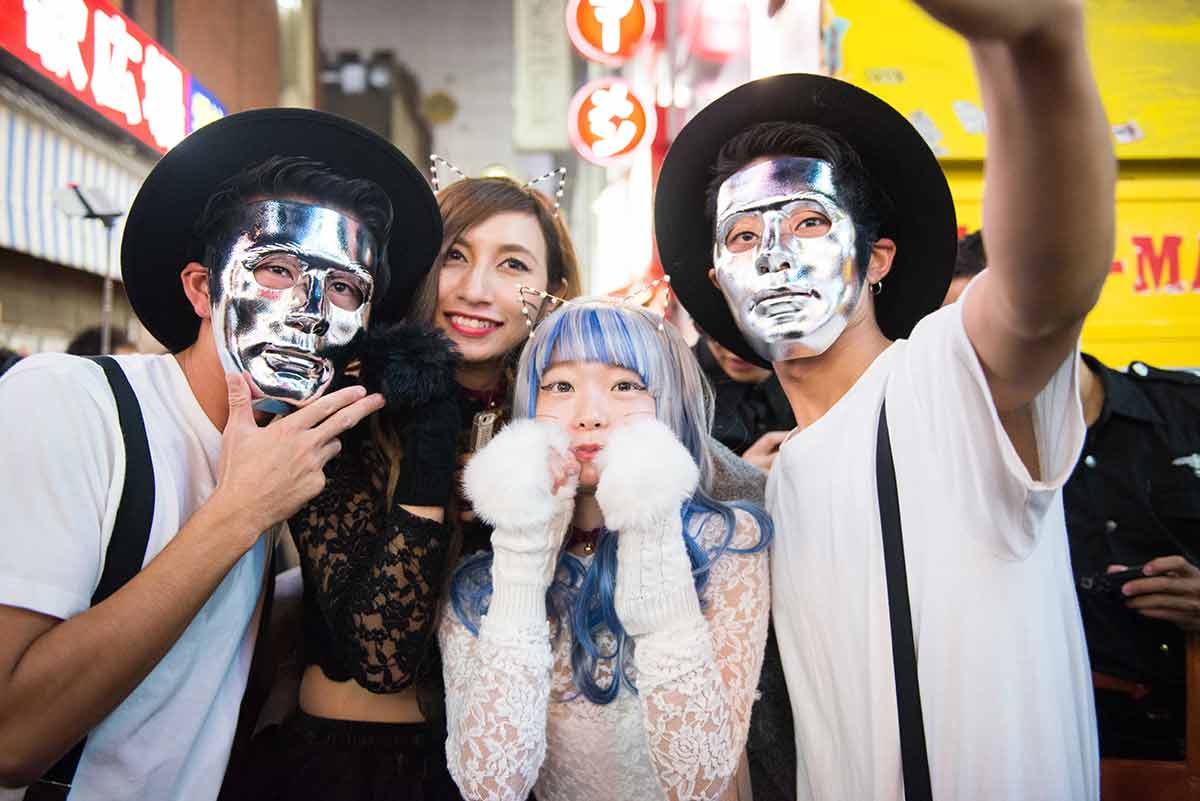
Though it is celebrated slightly differently than in America or Europe, Halloween has become a huge deal in Japan.
You’ll not find any trick or treaters going from door to door in the hope of snagging some free chocolate or sweets, but that doesn’t stop Japan from going Halloween crazy each October.
As much of a commercial enterprise as it is a traditional event, the popularity of Halloween in Japan has taken off massively in the past few decades.
Shops are often filled with Halloween themed costumes, decorations, toys and even food weeks before the Day itself.
The most famous Halloween celebration in Japan is held each year in and around the famous Shibuya Crossing, where close to 1 million people unofficially parade the streets in all kinds of crazy Halloween costumes.
5- See Japan’s Red Kochia Shrubs
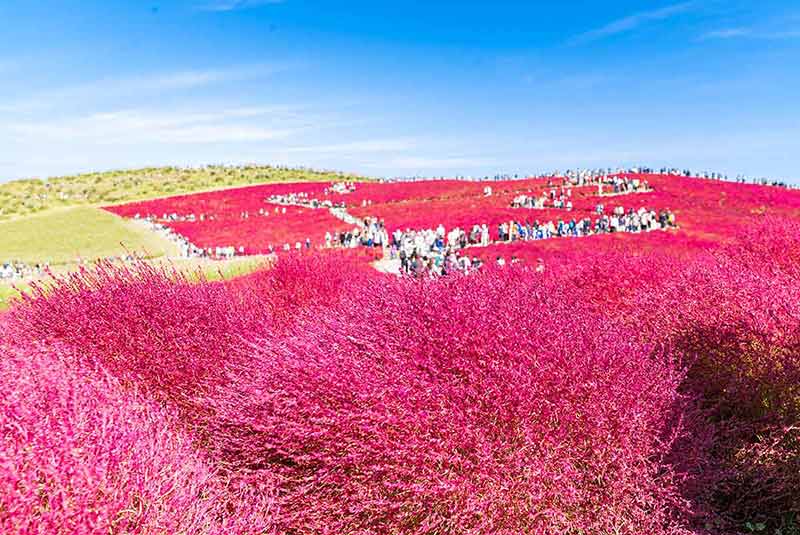
Autumn in Japan also provides the chance to admire another natural wonder.
Usually around mid-October, the kochia shrub suddenly turns a deep red colour for a few weeks only.
These cypress plants are a lush green for most of the year, but come the autumn, their colour changes, first showing a faint tint of red before transforming into a full-blown riot of rich reds.
The best place to see red kochia shrubs is the Hitachi Seaside Park in Ibaraki Prefecture, about an hour’s train ride north of Tokyo.
Japan Autumn Tips
- Japan in autumn is incredibly popular with both overseas visitors and Japanese tourists. If you’re planning on visiting Japan at this time of year, book flights and particularly accommodation well in advance. The same applies to train tickets, particularly for the Shinkansen bullet trains.
- Though early autumn is generally mild and sunny, temperatures can dip quite a few degrees towards the latter end of autumn. If you’re visiting towards the end of the season, pack a few warmer clothes as even on sunny days, it can get cold, and the temperature falls considerably after dark.
Japan in Winter
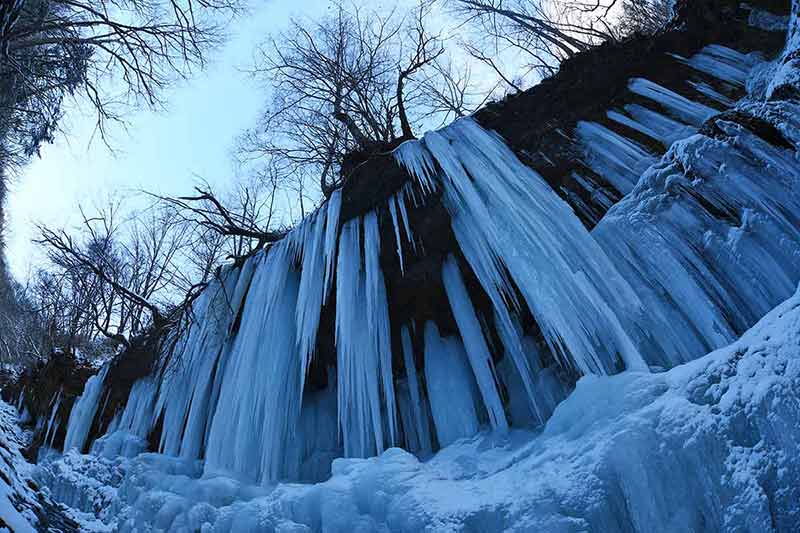
Winter is perhaps unfairly overlooked as a good time to visit Japan.
Although winter is by far the coldest time of the year, the days are often sunny, even if they are relatively short (it typically gets dark before 5 pm).
But winter is a great time to head to Japan if you’re after a bargain as the price of hotels and flights are usually much lower than at other times of the year.
Winter is the pick of the seasons to visit Japan if you love winter sports.
With much of the country’s north under several feet of thick snow, Japan has many world-class ski resorts that bring millions of visitors a year.
Be aware that the New Year period is possibly the most significant holiday season in the entire calendar in Japan, and many businesses, including restaurants, cafes, and tourist sites, shut down entirely from around 28 December to 3 January.
Average Weather In Japan In Winter

- December – Daylight hours = 10 hours, Average Low = 18 °C/64 °F, Average High = 22 °C/72 °F
- January – Daylight hours = 10 hours, Average Low = 15 °C/60 °F, Average High = 20 °C/69 °F
- February – Daylight hours = 11 hours, Average Low =15 °C/60 °F, Average High = 20 °C/69 °F
Things to do in Japan in Winter
1- See The Snow Monkeys
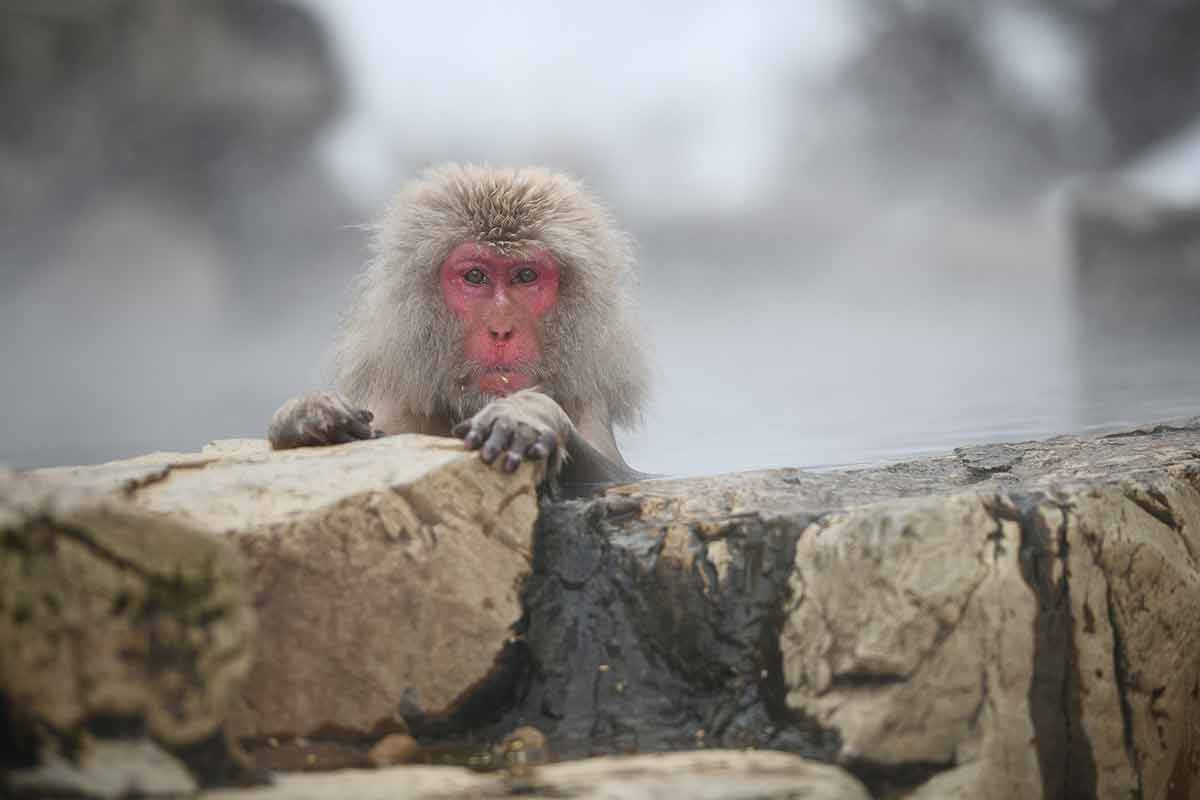
The Jigokudani Monkey Park in Nagano is home to an enormous group of cute Japanese macaques, also known as snow monkeys.
Although they occupy the park all year round, it’s during winter against a backdrop of thick white snow that the macaques are at their most photogenic.
During the cold of winter, the macaques are also more likely to bath in the park’s heated hot spring.
Though the park is a private area, the macaques are free to roam the forests around the surrounding valley.
They are enticed into the park by the free food on offer, which helps stop them from stealing crops from nearby farms.
The macaques are very comfortable around humans and completely ignore visitors.
2- Be Dazzled By Sapporo’s Snow Festival
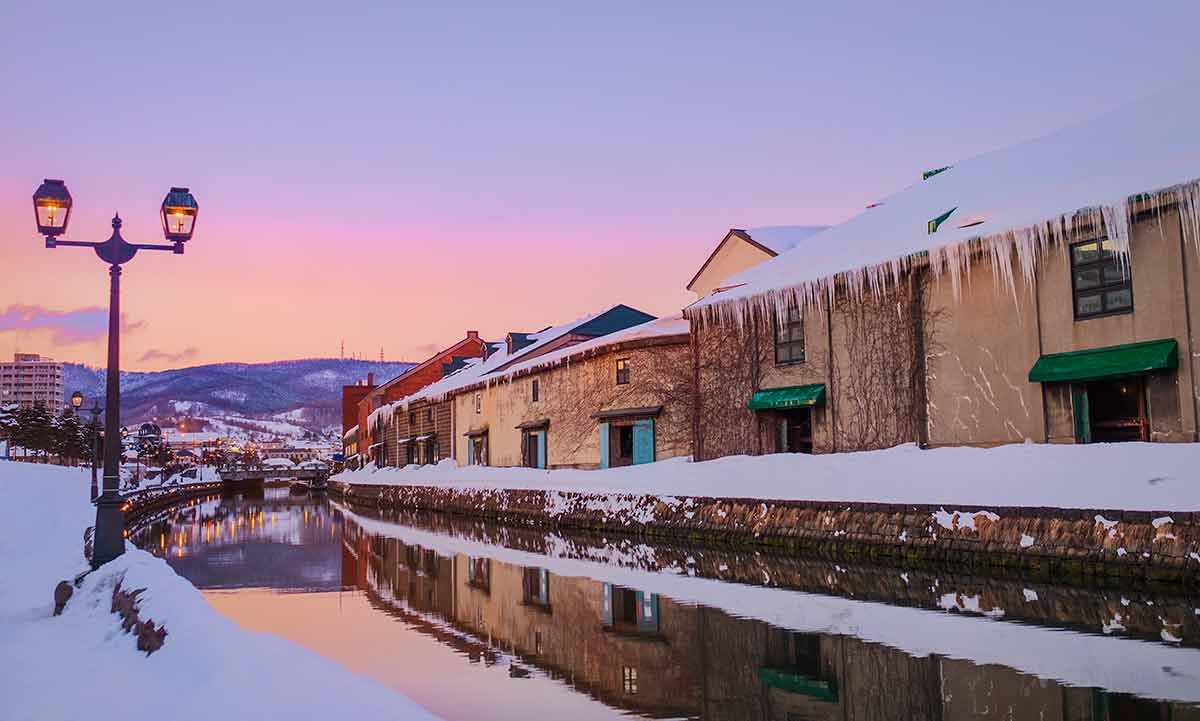
Each year Sapporo hosts the world-famous Sapporo Snow Festival, where massive intricately-carved ice sculptures are displayed at three different sites.
Held every February, the Sapporo Snow Festival began in the 1950s, developing into an annual event in which the ice sculptures became more and more lavish each year.
Now the festival sees enormous displays carved from massive blocks of ice.
The centrepiece of each festival is usually a gargantuan replica of a famous landmark.
The Sapporo Snow Festival takes place across three sites in the city.
The two main sites are at Odori and Susukino in the city’s centre.
These include breathtaking sculptures, usually following a single theme.
A third site, Tsudome, is more of a snow-based theme park, though there are ice sculptures on display here too.
3- Enjoy A KFC Christmas
In modern times, it has become a tradition in Japan to celebrate Christmas Day with a bucket of KFC chicken.
Following a highly successful marketing campaign in the 1970s, KFC became synonymous with Christmas in Japan, a country with practically no yuletide traditions up to that point.
Today, KFC chicken is seen as traditional Christmas fair in Japan. The chain sells millions of party barrels at Christmas every year, consisting of fried chicken, a Christmas cake and usually a commemorative Christmas plate.
Long queues form outside branches on the days leading up to Christmas day, though you can even order in advance to avoid standing in line.
4- Hit The Ski Slopes
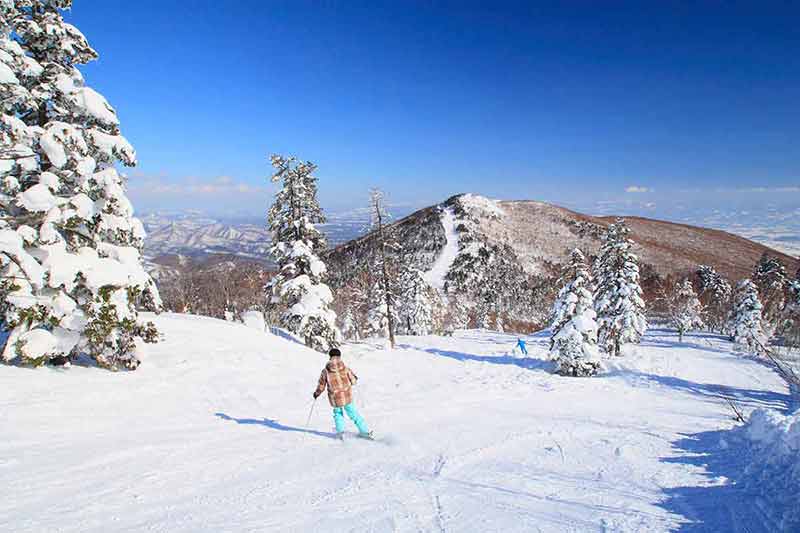
Northern Japan is a Mecca for those who love skiing and all manner of winter sports.
Known as being one of the best skiing destinations in the world, Hokkaido’s powder fresh snow combined with fantastic resorts filled with the very best facilities ensures that a massive influx of skiers and snowboarders flock here from around the world.
Resorts such as Niseko and Furano in Hokkaido are ideal whether you’re a seasoned pro or a beginner.
Many resorts also house luxurious cabins and their own private hot springs, making this the perfect place for a winter break.
5- Enjoy The Winter Illuminations
Japan is awash with fabulous winter illuminations in the run-up to Christmas and the New Year period.
Trees and gardens in commercial shopping areas (particularly near shopping malls), amusement parks and flower parks are decorated with displays of multi-coloured LED lights every year.
The winter illuminations go up almost as soon as the Halloween decorations have come down and stay up for most of December and often into the New Year.
Famous spots for winter illuminations in Tokyo include Tokyo Midtown and the Roppongi Hills shopping and entertainment complex.
The Yomiuriland amusement park just outside Tokyo is also covered in festive lights.
The illuminations at Nabana No Sato flower park at the Nagashima Resort in Nagoya are among Japan’s largest displays.
Japan Winter Tips
- The New Year period is one of the most important holidays in Japan, and many places completely close during this time.
- From 29 December to about 3 January, many bars, cafes, restaurants, and major tourist sites closed for around a week.
- If you are looking to spend the New Year period in Japan, do some research in advance and check to see if the things you plan to visit during your trip will be open.
Japan in Spring
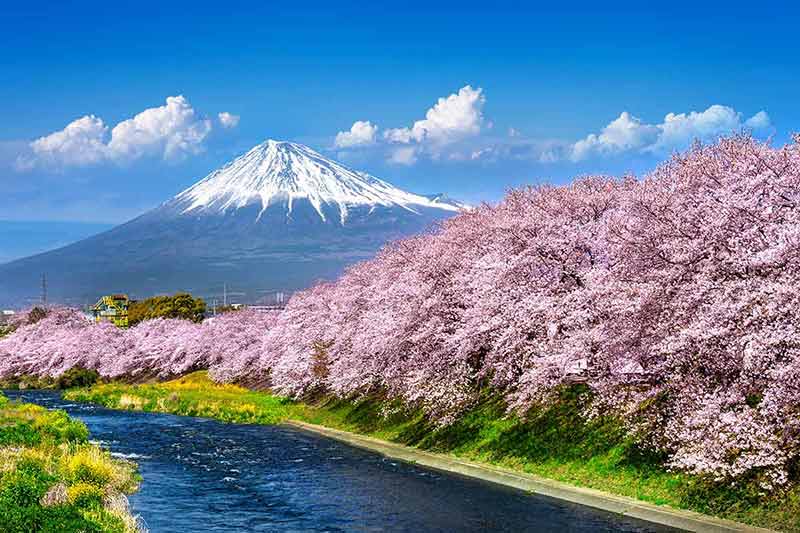
Spring is one of the best and most popular times to visit Japan.
This is largely thanks to the stunning cherry blossom season, which sees visitors fly into Japan from all over the world.
The cherry blossom season is also hugely popular within Japan, and many Japanese people travel across the country to see the bright pink blooms whilst they’re in season.
However, the cherry blossom season is incredibly short, starting in the south of Japan, usually towards the end of March, before reaching full bloom in Hokkaido by the end of April.
This means that the cherry blossom season is one of the busiest for travel in Japan, with flights, trains and accommodation all facing incredibly high demand.
For most of spring, the weather is excellent, with warm temperatures and sunny days making it a great time to visit Japan.
However, if you’re visiting Japan in spring, it’s best to avoid Golden Week, a period of four national holidays in quick succession at the end of April and the beginning of May.
These are usually taken as one long break and when much of Japan goes on holiday, and transport and accommodation in many parts of the country are often fully booked well in advance.
Average Weather In Japan In Spring
- March – Daylight hours = 12 hours, Average Low = 16 °C/62 °F, Average High = 21 °C/71 °F
- April – Daylight hours = 13 hours, Average Low = 18 °C/ 65 °F, Average High = 23 °C/74 °F
- May – Daylight hours = 14 hours, Average Low = 21 °C/ 70°F, Average High = 25 °C/78 °F
Things to do in Japan in Spring
1- Be Amazed by Japan’s Beautiful Cherry Blossoms
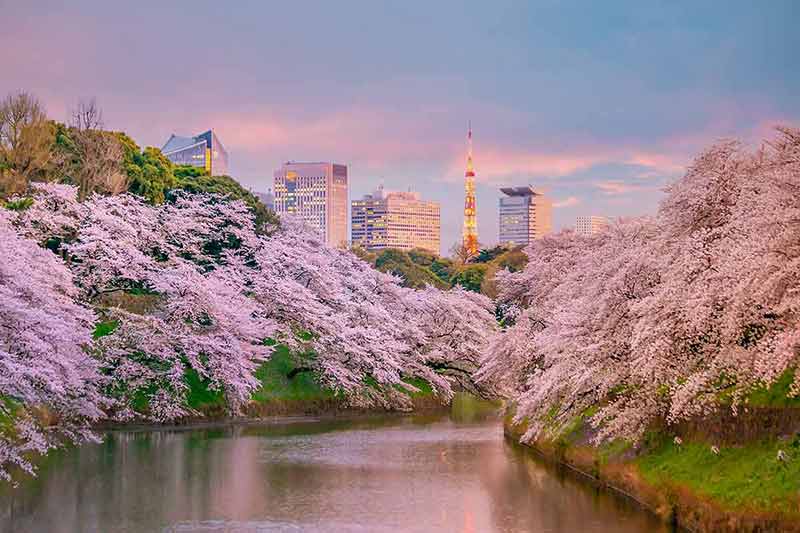
Arguably the most spectacular time to visit Japan is during the cherry blossom season in spring.
A phenomenal natural event, the blooming of Japan’s cherry blossoms brings millions of visitors every year and is a huge deal for Japanese people too.
At the start of every year, the countdown begins to the cherry blossom season.
Cherry blossom season forecasts screened on Japanese television predicting when the season will begin.
Japan’s cherry blossoms are only in bloom for a very brief period, which only adds to the season’s massive appeal.
Cherry blossom trees are practically everywhere in Japan, meaning that most gardens, parks, temples and shrines are awash with people when they’re in bloom.
The best spots to enjoy cherry blossoms in Tokyo are Ueno Park, Shinjuku Gyoen National Garden and all along the Meguro River.
2- Enjoy Children’s Day
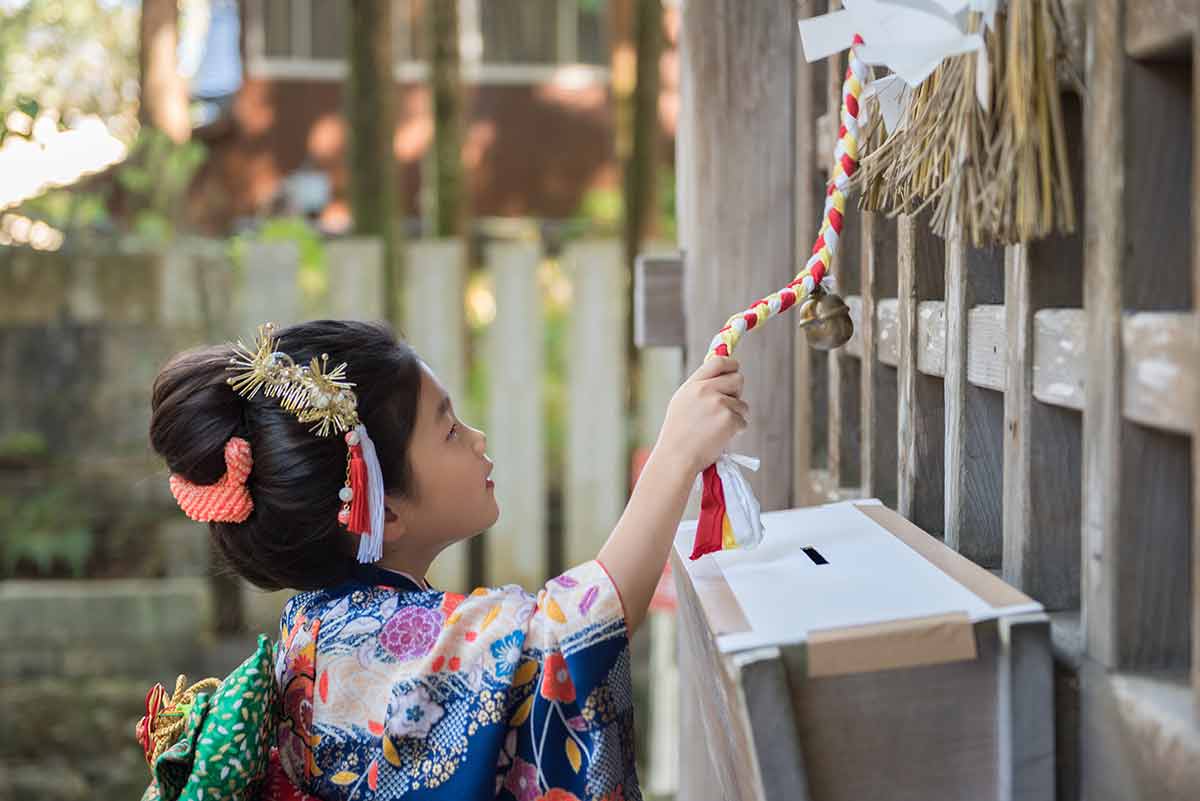
Children’s Day is a major national holiday in Japan that falls on 5 May every year.
Although called Children’s Day, the holiday was traditionally celebrated as Boy’s Day (3 March is known as Girl’s Day in Japan, although this isn’t a national holiday).
Children’s Day has developed and typically celebrates all family members, including the parents.
Yet Children’s Day draws a special focus on respecting the children’s talents and personalities.
The most visible sign of Children’s Day is the koi carp streamers that people hang up from their homes that fly in the wind.
The streamers, called koinobori in Japanese, consist of several colourful carp, each representing a different family member.
These cloth carp are said to bring fortune and good luck to the children of the house in the year ahead.
3- See Murudo’s Snow Corridor
If you’re a winter lover and still want to enjoy some snow in the spring, then Murodo in Japan’s Tateyama Kurobe Alpine Route is the place to be.
During winter, this region of Toyama Prefecture sees constant snow, making the area completely inaccessible until the spring.
By April, the area is reopened once the snow stops falling, with the Murodo snow corridor being the region’s most famous and photogenic site.
The Murodo snow corridor is formed from the road section that is cleared for buses to pass through.
An enormous chunk of snow is carved out to reveal the road.
This creates a towering wall of snow that frames either side of the road, with both sides often reaching as high as 20 metres.
Against a beautiful blue sky backdrop, the Murodo snow corridor is unlike anywhere else in Japan.
4- Go Strawberry Picking
Also in bloom in spring in Japan are strawberries.
Strawberry picking is a popular and fun family pastime each spring, and there are plenty of strawberry farms that are open to visit all over Japan.
Many regions across Japan specialise in producing strawberries, and farms open their doors specifically in spring, allowing visitors to pick their own (for a fee).
Many strawberry farms also offer visitors a small pot of cream to dip their pickings into and eat on the go.
Of the many strawberry farms in Japan, Kamakura Kanko Ichigo Farm in Kanagawa Prefecture is one of the easiest to get to from Tokyo.
Yoshimura Strawberry Park in Tochigi Prefecture, famous for its delicious strawberries, is another popular place to pick fruit.
5- See The Hanging Wisteria
It’s not only cherry blossoms that bloom in Japan in spring.
The season is also famous for the beautiful hanging wisteria that blossoms throughout Japan.
Wisteria flowers are typically a pale purple colour, though they can also be blue or pink.
In Japan, a much-loved flower, wisteria hang from purpose-built trellises in many places throughout the country, particularly in traditional gardens and temple grounds.
There are wonderful places in Japan to marvel at the wisteria in spring.
In Tokyo, the most famous spot is within the picturesque grounds of Kameido Tenjin Shrine.
Here the wisteria hangs against the backdrop of the temple grounds, including traditional arched vermillion bridges and the nearby Tokyo Skytree.
Japan Spring Tips
- If you’re planning to see the cherry blossoms in Japan during spring, you’ll need to plan. You’ll also need deep pockets. Due to the sheer beauty of the cherry blossom season, this is one of the busiest times to visit Japan. That demand means that the cost of travel and accommodation also rocket up during the cherry blossom season.
- It’s best to avoid travelling to Japan during Golden Week. Unless you’re booking your trip way in advance, most accommodation options will likely be limited or fully booked. Also, as most of Japan is on holiday, almost everywhere during Golden Week is usually incredibly busy, which is not the best time to visit. Prices for travel and accommodation are generally very high during Golden Week too.
Are you itching to travel somewhere but can’t decide where or when to go? These posts might help:
- Best Time To Visit Iceland
- Best Time To Visit Macau
- Best Time To Visit Singapore
- Best Time To Visit China
- Best Time To Visit Egypt
- Best Time To Visit Japan
- Best Time To Visit Cuba
- Best Time To Visit England
- Best Time To Visit Peru
- Best Time To Visit Spain
- Best Time To Visit California
- Best Time To Visit Colorado
- Best Time To Visit Turkey
- Best Time To Visit Greece
- Best Time To Visit France
- Best Time To Visit Switzerland
- Best Time To Visit Norway
- Best Time To Visit Italy
- Best Time To Visit Germany
- Best Time To Visit Thailand
- Best Time To Visit Portugal
- Best Time To Visit Croatia
- Best Time To Visit Scotland
- Best Time To Visit Costa Rica
- Best Time To Visit Argentina
- Best Time To Visit Brazil
- Best Time To Visit Chile
- Best Time To Visit Austria
- Best Time To Visit India
Plan Your Trip

Rent A Car – Find the best car rental rates at Discover Cars. They compare car hire companies to provide you with the best deal right now.

Find A Hotel – If you’re curious about this article and are looking for somewhere to stay, take a look at these amazing hotels.

